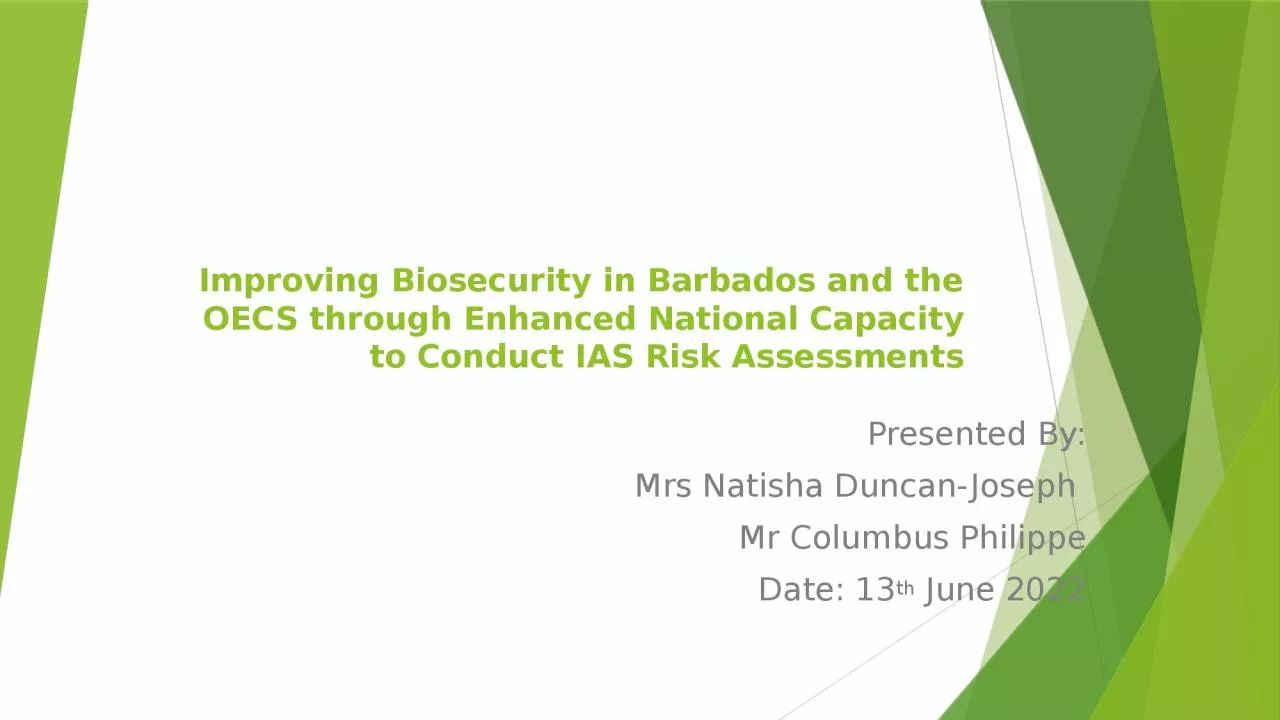

Presented By Mrs Natisha DuncanJoseph Mr Columbus Philippe Date 13 th June 2022 COUNTRY REPORT ST LUCIA ORGANISATION OF BIOSECURITY The Ministry of Agriculture through the following divisions executes the functions of the islands biosecurity ID: 1033558
Download Presentation The PPT/PDF document "Improving Biosecurity in Barbados and th..." is the property of its rightful owner. Permission is granted to download and print the materials on this web site for personal, non-commercial use only, and to display it on your personal computer provided you do not modify the materials and that you retain all copyright notices contained in the materials. By downloading content from our website, you accept the terms of this agreement.
1. Improving Biosecurity in Barbados and the OECS through Enhanced National Capacity to Conduct IAS Risk AssessmentsPresented By:Mrs Natisha Duncan-Joseph Mr Columbus PhilippeDate: 13th June 2022
2. COUNTRY REPORTST LUCIA
3. ORGANISATION OF BIOSECURITY The Ministry of Agriculture through the following divisions executes the functions of the island’s biosecurity. Crop Protection and Quarantine Veterinary & Livestock Services Forestry Department (limited)Fisheries Department (limited)
4. ORGANIZATIONAL OUTLOOKThere is an advanced initiative to merge key government agencies to form a single ‘border protection’ agency.CustomsImmigrationMarine and Port PolicePlant QuarantineAnimal QuarantinePort Health
5. IMPORTATION PROCESS An application for an import permit to import any plant or plant related commodity or any live animal or product of animal origin and seafood products into Saint Lucia has to be completed and submitted by the customer.
6. IMPORTATION continuedApplication for commodities which are regularly imported and of low risk has a shorter time for approval to be granted. Commodities of higher risk has longer approval time since pest risk analysis has to be conducted to determine the outcome of the application.
7. IMPORTATION continuedCABI Compendium is used as a guide to determine import requirement for new product or products that has not been imported for a long timeIt is also used to verify invasiveness of plant specie import requestDistribution of pests of plants on the CABI website is also used to help determine the decision to import
8. ImportsPest Risk Analysis exist for pests and diseases of plants, animals, and their products.
9. ST. LUCIA PORTS OF ENTRYG. F. L. Charles AirportHewanora International AirportCastries SeaportVieux-Fort SeaportRodney Bay MarinaMarigot BaySoufriere Bay
10. PORTS OF ENTRY continuedWith the increase in online shopping, courier service establishments have become a point of entry of regulated goods. Notwithstanding, import regulations must be applied.
11. Animal regulated diseases of Bovine Spongiform Encephalopathy (BSE)RabiesAvian Influenza (AI)Foot and Mouth Disease (FMD)NewcastleHog CholeraAfrican Swine Fever (ASF)
12. Plant regulated pestFusarium wilt (TR4)Lethal yellowingRed palm weevilCitrus cankerMoko diseaseTuta absolutaMexican fruit fly
13. EXPORTATIONPersons who wish to export any plants, plant related commodities or animals, animal products and sea food from St. Lucia to any country has to meet the import requirements of that country. Commodities that are prohibited entry into any country is denied export.
14. EXPORTATION continuedDocuments required for export includes some of the following:Import permitPhytosanitary certificateTreatment certificateHealth certificateCertificate of wholesomenessCITES certificate for items which are endangered
15. INSPECTIONFor casual imports, the customs department is our first line of defence. Any item that is of plant or animal origin is detained and an officer from the Plant Quarantine or Veterinary and Livestock Unit is informed.
16. INSPECTION continuedDocument for detained item is obtained if available and reviewed.Item is examined and if it meets the necessary conditions for import it is released for entry. If conditions are not what is regulated the item is confiscated for disposal.
17. INSPECTION continuedFor commercial imports, there is an established inspectorate which conducts inspections on imported meats, meat products, fruits, vegetables containerized and break bulk. These inspections are either at the ports or at the business premises.
18. SURVEILLANCE AND MONITORINGThere is an ongoing surveillance for fruit flies, tuta absoluta monitoringActive surveillance and monitoring for the amblyomma variegatum tick, and varora mite in bees. Receive bulletins, updates and alerts from international, regional organizations on outbreaks.
19. SURVEILLANCE Continued Establishment of the National Agricultural Diagnostic Facility (NADF)Animal HealthPlant HealthFeed TestingSoil TestingStandards
20. PUBLIC AWARENESSPublic education is an ongoing activity which entails a series of events through out the year.Weekly television and radio programsQuarantine awareness month‘Don’t Pack a Pest’ campaign which targets travelers.
21. INVASIVE SPECIESInvasive species of note which could have a negative impact on the country’s biodiversity. The presence of the green iguana on island is worrisome. Likewise the sightings of Tufted Capuchin Monkey and Green Monkey troops in the wild.
22. Invasive species continueIndigenous St. Lucian IguanaInvasive Green Iguana
23. Two invasive plants on Gros PitonWandering JewCallisia fragans
24. Invasive species continueThreats of invasive species to the island include but not limited toCompetition with indigenous species for food and habitatAgricultural pestImbalance in the local ecosystemLoss of biodiversity
25. THANK YOU
26. QUESTIONS?